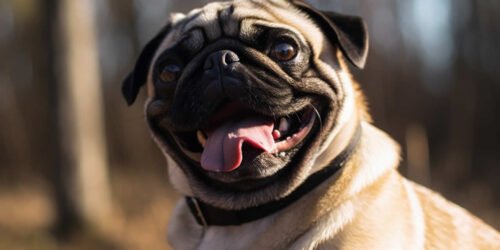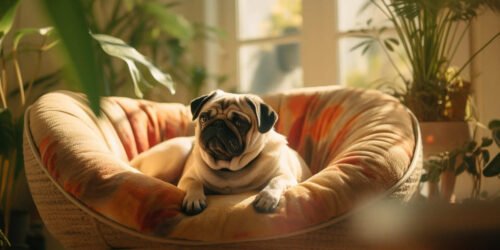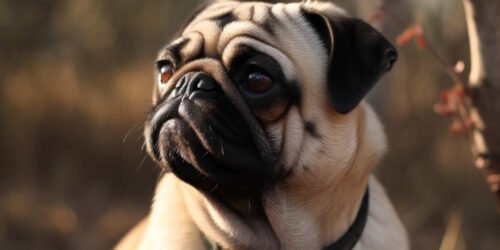Why Is My Pug So Aggressive?
Introduction
“Are you perplexed by your normally sweet-natured pug suddenly showing signs of aggression? Believe me, I understand how disconcerting this experience can be, especially since pugs are generally known for their friendly and affectionate disposition.
This article is designed to dissect the root causes of an aggressive Pug, from potential health issues to behavioural triggers. Stay with us as we navigate through effective solutions that will help restore your cuddly companion’s calmness.”
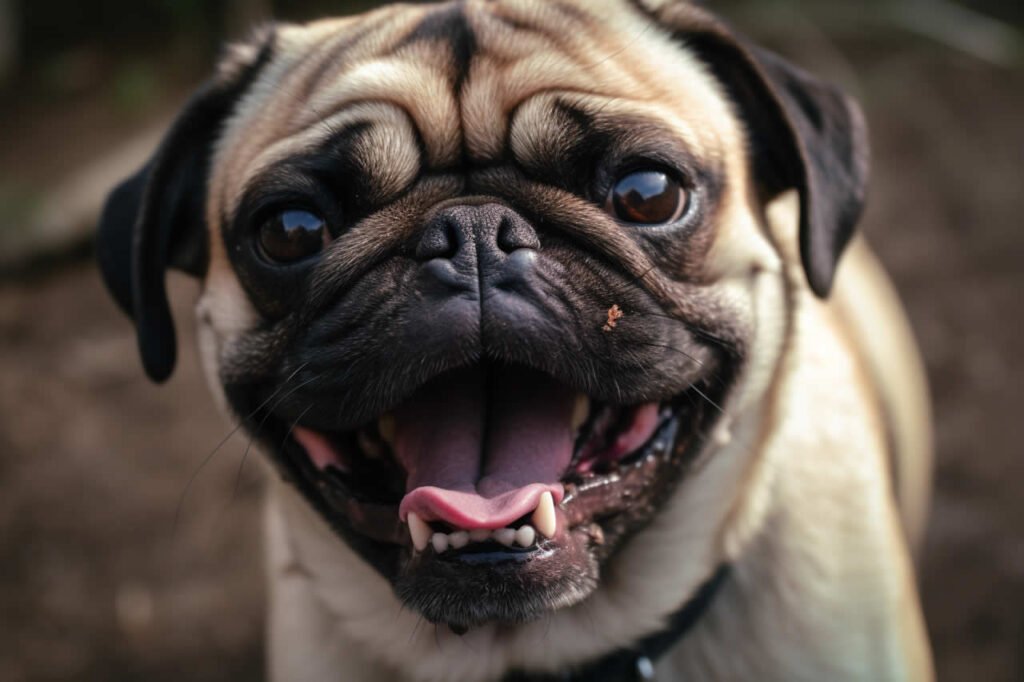
Table of Contents
- Introduction
- Understanding Aggression In Pugs
- Aggression Towards Other Dogs
- Aggression Towards Humans
- Dealing With Aggressive Behaviours In Pugs
- Conclusion
- FAQs
Key Takeaways
- Pugs are not naturally aggressive dogs and their friendly temperament is a reflection of their breed characteristics.
- Lack of socialisation and past traumatic experiences can contribute to aggression in pugs towards other dogs and humans.
- Health issues such as thyroid disorders or pain – related conditions may trigger
aggressive behaviour in pugs, so regular veterinary care is essential for addressing these issues.
- Proper socialisation, obedience training, and positive reinforcement techniques play a significant role in managing aggression in pugs.
Understanding Aggression In Pugs
Pugs, known for their friendly and affectionate nature, are not naturally aggressive dogs. However, there can be various causes for aggression in pugs that require understanding and attention to effectively address their behaviour.
Pug’s Temperament: Not Naturally Aggressive
Despite common misconceptions, Pugs aren’t naturally aggressive dogs. A true reflection of the friendly Pug temperament is one filled with love, affection, and boundless enthusiasm.
Their expressive eyes mirror their outgoing nature – always ready to play and please their owners.
This doesn’t mean that a Pug can’t demonstrate aggression; indeed, like any breed, they’re capable if pushed into uncomfortable circumstances or lacking proper upbringing. In essence though, your joyful little bundle was not bred for hostility but companionship.
Understanding this about the Pug’s temperament forms the essential base in avoiding future Pug aggression incidents while fostering a harmonious relationship with your adorable pet.
Causes Of Aggression In Pugs
Pugs, like every other breed, have the potential to exhibit aggressive behaviour. However, this does not mean they are naturally aggressive dogs. The triggers for aggression in Pugs can be vast and complex.
One major cause is a lack of socialisation during their crucial puppy development stages. Ensuring your Pug interacts with other dogs and humans at an early age can help them learn acceptable behaviour patterns.
It’s also prudent to stay informed about medical conditions that may contribute to their unusual aggressiveness. For instance, thyroid disorders have been linked with aggression in Pugs as well as many other breeds.
When our furry friends experience pain or discomfort due to underlying health issues, they may respond aggressively out of fear or stress. Always keep an eye on any sudden changes in their behaviour; it could be a cry for help needing immediate veterinary care.
Aggression Towards Other Dogs
It’s essential to pinpoint the factors contributing to your Pug’s combative stance. Like most breeds, Pugs may display aggressive tendencies due to a fearful response. This can manifest in behaviours like barking, lunging, and nipping at other dogs especially during uncomfortable or new encounters.
Another significant aspect is lack of socialisation. Without adequate exposure to various environments and fellow canines from an early age, your Pug might become wary of unfamiliar dogs leading to reactive behaviour.
A simple stroll in the park could quickly morph into a stressful ordeal if they view every passing pooch as a threat. Past traumatic experiences also play a role in escalating aggression triggers in this otherwise affable breed.
Health-related aggression cannot be ruled out either; discomfort from an undiagnosed ailment or injury often gets misinterpreted as unfounded dog aggression causing immense confusion for pet parents trying hard to comprehend sudden changes in their friendly furball’s demeanour.
Aggression Towards Humans
As an owner of a pug, you may wonder why your furry friend can sometimes display aggression towards humans. It’s important to note that pugs are not naturally aggressive creatures, but like any dog breed, they can exhibit aggressive behaviours under certain circumstances.
One common reason for aggression towards humans is when pugs feel the need to protect their owners. Pugs are known for their strong bond with their families and will go to great lengths to keep them safe.
If they perceive a threat or believe that someone is causing harm to their loved ones, they may show signs of aggression as a protective response.
However, aggression in pugs can also stem from fear or surprise. These small dogs may feel overwhelmed when approached too suddenly or if faced with unfamiliar people. Inadequate socialisation during puppyhood can also contribute to behavioural issues later on, including aggression towards humans.
Additionally, it’s essential to consider potential health issues that could be triggering your pug’s aggressive behaviour. Pain or discomfort caused by medical conditions such as arthritis or dental problems can make them more reactive and prone to displaying aggressive tendencies.
To address aggression towards humans in your pug, it’s crucial first and foremost to ensure their safety and the safety of those around them. Consulting with a professional dog trainer or behaviourist who specialises in positive reinforcement techniques might be beneficial.
They can help you develop strategies for teaching your pug appropriate behaviour and managing situations where aggression arises.
Remember that patience and consistency are key when dealing with these behaviours in your beloved pet companion. With proper socialisation and obedience training alongside regular veterinary care, you’ll increase the chances of reducing your pug’s aggressive tendencies over time.
Dealing With Aggressive Behaviours In Pugs
To address aggressive behaviours in your pug, proper socialisation, obedience training, and regular veterinary care are crucial. It’s important to understand the underlying causes of aggression and implement effective strategies for managing it.
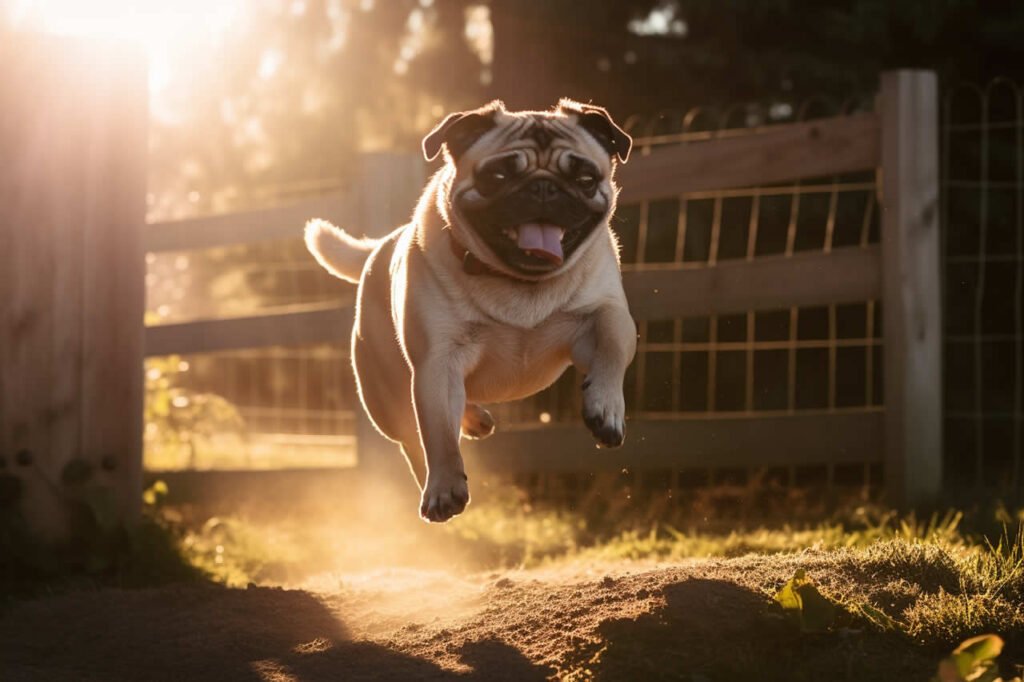
Socialisation
Socialisation is a crucial aspect of raising a well-behaved and friendly Pug. It involves exposing your furry friend to various experiences, people, animals, and environments from an early age.
This helps them develop positive associations and understand how to interact with the world around them.
By socialising your Pug, you can help prevent aggressive behaviours from developing in the first place. It allows them to learn appropriate ways of interacting with other dogs, humans, and different situations.
Regularly exposing your Pug to new experiences will make them more confident and less likely to display aggression towards unfamiliar people or animals.
When socialising your Pug, it’s important to take things slow and not overwhelm them. Gradually introduce them to new people, places, and situations in a calm manner. Positive reinforcement techniques can be used during these encounters to reward good behaviour.
Remember that consistent training plays a significant role in ensuring successful socialisation for your Pug.
Incorporating obedience training into their socialisation routine is also beneficial for managing any potential aggression issues. Obedience training helps establish boundaries and teaches your Pug proper manners when interacting with others.
Veterinary care is another critical component of addressing aggression in pugs since underlying medical conditions may sometimes contribute to disruptive behaviour or pain-related aggression issues (citation).
Consulting with a veterinarian who specialises in behavioural problems can help rule out any medical causes for aggression.
Obedience Training
Obedience training plays a crucial role in managing and addressing aggressive behaviours in Pugs. As a proud owner of a Pug, it is important to understand the significance of obedience training for your furry friend. Here are some essential tips to keep in mind:
- Start early: Begin obedience training from an early age to establish good behaviour patterns and prevent aggression from developing. Pugs are intelligent dogs and can quickly learn commands and boundaries.
- Consistency is key: Be consistent with your commands, rules, and expectations. Use clear and firm instructions to teach your Pug what is acceptable behaviour. Reinforce positive behaviours with treats or praise to encourage them to repeat those actions.
- Positive reinforcement: Reward-based training techniques work best for Pugs. Use treats, toys, or verbal praise as rewards for following commands correctly or displaying calm behaviour. This positive association helps them understand what you expect from them.
- Avoid punishment: Punishing your Pug for aggressive behaviour can make matters worse. It can increase fear or anxiety, leading to more aggressive tendencies. Focus on redirecting their attention and rewarding good behaviour instead.
- Socialisation: Socialising your Pug with other dogs, animals, and different
environments is crucial for their overall temperament and preventing aggression later on. Expose them to various situations gradually and positively reinforce their calm reactions.
- Seek professional help if needed: If you’re struggling with addressing your Pug’s aggressive behaviours despite consistent obedience training, consider consulting a professional dog trainer or behaviourist who specialises in working with aggressive dogs.
Veterinary Care
Regular veterinary care plays a crucial role in addressing and managing aggressive behaviours in Pugs. As pug owners, we need to prioritise our dog’s overall health and well-being by scheduling routine check-ups with a trusted veterinarian.
Aggressive behaviour can sometimes be linked to underlying medical conditions or pain, so it’s important for the vet to thoroughly examine your pug and rule out any physical causes. Additionally, your veterinarian can provide valuable guidance on behavioural issues specific to Pugs and recommend appropriate training techniques or interventions tailored to your individual pet.
By working closely with a veterinarian experienced in handling aggression in dogs, we can ensure that our pugs receive the best possible care and support for their unique needs.
Conclusion
In conclusion, it’s important to understand that aggression in pugs is not a natural trait and can be influenced by various factors such as fear, lack of socialisation, or past trauma. By providing proper training, socialisation, veterinary care, and understanding their individual needs, owners can help minimise aggressive behaviours in their pugs.
Remember that with patience and consistency, your pug can become a well-behaved and happy companion.
FAQs
1. What are some common reasons why a pug may exhibit aggressive behaviour?
There can be several reasons why a pug may display aggression, including fear, lack of socialisation, past traumatic experiences, territoriality, resource guarding, or medical issues. It’s important to identify the underlying cause to address and manage the aggression effectively.
2. How can I help my pug overcome their aggressive behaviour?
Helping your pug overcome aggression requires professional guidance from a qualified dog trainer or animal behaviourist who can assess the specific triggers and develop an individualised training plan. This plan may include positive reinforcement techniques, desensitisation exercises, behaviour modification strategies, and implementing consistent rules and boundaries at home.
3. Should I punish my pug for being aggressive?
Punishing an aggressive pug is not recommended as it can escalate the situation further and potentially reinforce negative behaviours. Instead of punishment, focus on redirecting their attention towards positive behaviours through reward-based training methods.
4. Could my pug’s aggression be due to a medical issue?
Yes, certain medical conditions or hormonal imbalances can contribute to behavioural changes in dogs that manifest as aggression. If you notice sudden or unexplained aggression in your pug, it is essential to consult with a veterinarian who can rule out any underlying health problems before focusing on behavioural interventions.

